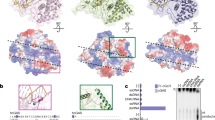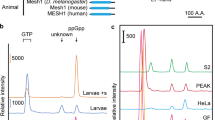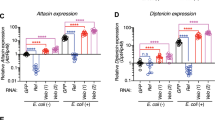Abstract
The activation of an immune response requires recognition of microorganisms by host receptors. In drosophila, detection of Gram-positive bacteria is mediated by cooperation between the peptidoglycan-recognition protein-SA (PGRP-SA) and Gram-negative binding protein 1 (GNBP1) proteins. Here we show that some Gram-positive bacterial species activate an immune response in a PGRP-SA- and GNBP1-independent manner, indicating that alternative receptors exist. Consistent with this, we noted that PGRP-SD mutants were susceptible to some Gram-positive bacteria and that a loss-of-function mutation in PGRP-SD severely exacerbated the PGRP-SA and GNBP1 mutant phenotypes. These data indicate that PGRP-SD can function as a receptor for Gram-positive bacteria and shows partial redundancy with the PGRP-SA–GNBP1 complex.
This is a preview of subscription content, access via your institution
Access options
Subscribe to this journal
Receive 12 print issues and online access
$209.00 per year
only $17.42 per issue
Buy this article
- Purchase on Springer Link
- Instant access to full article PDF
Prices may be subject to local taxes which are calculated during checkout





Similar content being viewed by others
References
Bulet, P., Charlet, M. & Hetru, C. in Infectious disease: Innate Immunity (ed. Hoffmann, J.A. and Ezekowitz, R.A.B.) 89–107 (Human, Totowa, New Jersey, 2002).
Zasloff, M. Antimicrobial peptides of multicellular organisms. Nature 415, 389–395 (2002).
De Gregorio, E., Spellman, P.T., Rubin, G.M. & Lemaitre, B. Genome-wide analysis of the Drosophila immune response by using oligonucleotide microarrays. Proc. Natl. Acad. Sci. USA 98, 12590–12595 (2001).
Irving, P. et al. A genome-wide analysis of immune responses in Drosophila. Proc. Natl. Acad. Sci. USA 98, 15119–15124 (2001).
Hoffmann, J.A. The immune response of Drosophila. Nature 426, 33–38 (2003).
Brennan, C.A. & Anderson, K.V. Drosophila: the genetics of innate immune recognition and response. Annu. Rev. Immunol. 22, 457–483 (2004).
Michel, T., Reichhart, J.M., Hoffmann, J.A. & Royet, J. Drosophila Toll is activated by Gram-positive bacteria through a circulating peptidoglycan recognition protein. Nature 414, 756–759 (2001).
Gobert, V. et al. Dual activation of the Drosophila Toll pathway by two pattern recognition receptors. Science 302, 2126–2130 (2003).
Pili-Floury, S. et al. In vivo RNAi analysis reveals an unexpected role for GNBP1 in the defense against Gram-positive bacterial infection in Drosophila adults. J. Biol. Chem. 279, 12848–12853 (2004).
Gottar, M. et al. The Drosophila immune response against Gram-negative bacteria is mediated by a peptidoglycan recognition protein. Nature 416, 640–644 (2002).
Ramet, M., Manfruelli, P., Pearson, A., Mathey-Prevot, B. & Ezekowitz, R.A. Functional genomic analysis of phagocytosis and identification of a Drosophila receptor for E. coli. Nature 416, 644–648 (2002).
Choe, K.M., Werner, T., Stoven, S., Hultmark, D. & Anderson, K.V. Requirement for a peptidoglycan recognition protein (PGRP) in Relish activation and antibacterial immune responses in Drosophila. Science 296, 359–362 (2002).
Werner, T. et al. A family of peptidoglycan recognition proteins in the fruit fly Drosophila melanogaster. Proc. Natl. Acad. Sci. USA 97, 13772–13777 (2000).
Leulier, F. et al. The Drosophila immune system detects bacteria through specific peptidoglycan recognition. Nat. Immunol. 4, 478–484 (2003).
Yoshida, H., Kinoshita, K. & Ashida, M. Purification of a peptidoglycan recognition protein from hemolymph of the silkworm, Bombyx mori. J. Biol. Chem. 271, 13854–13860 (1996).
Liu, C., Gelius, E., Liu, G., Steiner, H. & Dziarski, R. Mammalian peptidoglycan recognition protein binds peptidoglycan with high affinity, is expressed in neutrophils, and inhibits bacterial growth. J. Biol. Chem. 275, 24490–24499 (2000).
Liu, C., Xu, Z., Gupta, D. & Dziarski, R. Peptidoglycan recognition proteins: a novel family of four human innate immunity pattern recognition molecules. J. Biol. Chem. 276, 34686–34694 (2001).
Kang, D., Liu, G., Lundstrom, A., Gelius, E. & Steiner, H. A peptidoglycan recognition protein in innate immunity conserved from insects to humans. Proc. Natl. Acad. Sci. USA 95, 10078–10082 (1998).
Tydell, C.C., Yount, N., Tran, D., Yuan, J. & Selsted, M.E. Isolation, characterization, and antimicrobial properties of bovine oligosaccharide-binding protein. A microbicidal granule protein of eosinophils and neutrophils. J. Biol. Chem. 277, 19658–19664 (2002).
Steiner, H. Peptidoglycan recognition proteins: on and off switches for innate immunity. Immunol. Rev. 198, 83–96 (2004).
Mellroth, P., Karlsson, J. & Steiner, H. A scavenger function for a Drosophila peptidoglycan recognition protein. J. Biol. Chem. 278, 7059–7064 (2003).
Kim, M.S., Byun, M. & Oh, B.H. Crystal structure of peptidoglycan recognition protein LB from Drosophila melanogaster. Nat. Immunol. 4, 787–793 (2003).
Gelius, E., Persson, C., Karlsson, J. & Steiner, H. A mammalian peptidoglycan recognition protein with N-acetylmuramoyl-L-alanine amidase activity. Biochem. Biophys. Res. Commun. 306, 988–994 (2003).
Wang, Z.M. et al. Human peptidoglycan recognition protein-L is an N-acetylmuramoyl-L-alanine amidase. J. Biol. Chem. 278, 49044–49052 (2003).
Bellen, H.J. et al. The BDGP gene disruption project: single transposon insertions associated with 40% of Drosophila genes. Genetics 167, 761–781 (2004).
Lee, M.H. et al. Peptidoglycan recognition proteins involved in 1,3-β-D-glucan-dependent prophenoloxidase activation system of insect. J. Biol. Chem. 279, 3218–3227 (2004).
Kaneko, T. et al. Monomeric and polymeric Gram-negative peptidoglycan but not purified LPS stimulate the Drosophila IMD pathway. Immunity 20, 637–649 (2004).
Lemaitre, B., Nicolas, E., Michaut, L., Reichhart, J.M. & Hoffmann, J.A. The dorsoventral regulatory gene cassette spatzle/Toll/cactus controls the potent antifungal response in Drosophila adults. Cell 86, 973–983 (1996).
Rutschmann, S., Kilinc, A. & Ferrandon, D. Cutting edge: the toll pathway is required for resistance to gram-positive bacterial infections in Drosophila. J. Immunol. 168, 1542–1546 (2002).
Rutschmann, S. et al. Role of Drosophila IKK γ in a toll-independent antibacterial immune response. Nat. Immunol. 1, 342–347 (2000).
Weber, A.N. et al. Binding of the Drosophila cytokine Spatzle to Toll is direct and establishes signaling. Nat. Immunol. 4, 794–800 (2003).
Schleifer, K. & Kandelr, P. Peptidoglycan types of bacterial cell walls and their taxonomic implications. Bacteriol. Rev. 36, 407–477 (1972).
Tauszig-Delamasure, S., Bilak, H., Capovilla, M., Hoffmann, J.A. & Imler, J.L. Drosophila MyD88 is required for the response to fungal and Gram-positive bacterial infections. Nat. Immunol. 3, 91–97 (2002).
de Jonge BL, C.Y., Gage D, Tomasz A. Peptidoglycan composition of a highly methicillin-resistant Staphylococcus aureus strain. The role of penicillin binding protein 2A. J. Biol. Chem. 267, 11248–11254 (2004).
Girardin, S.E. et al. Nod2 is a general sensor of peptidoglycan through muramyl dipeptide (MDP) detection. J. Biol. Chem. 278, 8869–8872 (2003).
Acknowledgements
We thank S. Ozkan and M.C. Lacombe for technical help; F. Dromer for the C. neoformans strain; and M. Meister for comments on the manuscript. Supported by Centre National de la Recherche Scientifique, the Ministère de l'Education Nationale de la Recherche et de la Technologie, the Fondation pour la Recherche Médicale and the National Institutes of Health.
Author information
Authors and Affiliations
Corresponding author
Ethics declarations
Competing interests
The authors declare no competing financial interests.
Supplementary information
Supplementary Fig. 1
Molecular characterisation of PGRP-SD protein null mutants. (PDF 25 kb)
Supplementary Fig. 2
PGRP-SD mRNA level in PGRP-SA;PGRP-SD double mutant flies over-expressing the PGRP-SD cDNA. (PDF 21 kb)
Supplementary Fig. 3
Effects of PGRP-SA, GNBP-1 and PGRP-SD overexpression on Toll pathway activation. (PDF 24 kb)
Rights and permissions
About this article
Cite this article
Bischoff, V., Vignal, C., Boneca, I. et al. Function of the drosophila pattern-recognition receptor PGRP-SD in the detection of Gram-positive bacteria. Nat Immunol 5, 1175–1180 (2004). https://doi.org/10.1038/ni1123
Received:
Accepted:
Published:
Issue Date:
DOI: https://doi.org/10.1038/ni1123
This article is cited by
-
Sensing microbial infections in the Drosophila melanogaster genetic model organism
Immunogenetics (2022)
-
Characterization of PGRP-LB and immune deficiency in the white-backed planthopper Sogatella furcifera (Hemiptera: Delphacidae)
Applied Entomology and Zoology (2022)
-
Identification, Phylogeny and Expressional Profiles of Peptidoglycan Recognition Protein (PGRP) Gene Family in Sinonovacula constricta
Journal of Ocean University of China (2022)
-
Numerous peptidoglycan recognition protein genes expressed in the bacteriome of the green rice leafhopper Nephotettix cincticeps (Hemiptera, Cicadellidae)
Applied Entomology and Zoology (2020)
-
Functional insights from the GC-poor genomes of two aphid parasitoids, Aphidius ervi and Lysiphlebus fabarum
BMC Genomics (2020)



